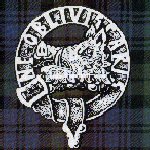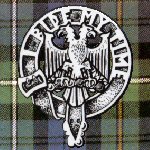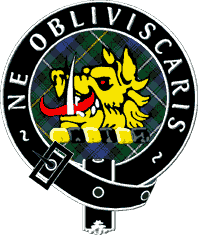Clan Campbell Information
The ancestors of the Campbells were already great territorial Lords in Scotland even before their emergence as a clan in the late 1200s. They held lands in Perthshire, Clackmannan, Dunbarton, Ayr, and Argyll. The records of 1293-1296 show five knights of the family then holding lands or office in Argyll alone.

Campbell

Campbell of Breadalbane

Campbell of Cawdor

Campbell of Loudoun
The traditional Gaelic pedigrees give the origins of the family as being descended from the Britonic Celts of the Lennox, immediately to the east of Argyll, and based upon the Dun of the Britons - now called Dunbarton Rock. The original family name was O'Duibne (Pron. Oh DOON yea). Probably about the time of the death of Somerled, Regulus of Argyll in 1163, Gillespic O'Duibne married Eva, a Dalriadic heiress of Lochawe in Argyll, whose father, Paul, a Sparain, may well have been Treasurer of Somerled. Tradition holds that her mother was daughter of the King of Man.
The lands of Lochawe were likely confirmed and expanded during King Alexander's expedition to subdue Argyll in 1222, when Gillespic and Eva O'Duibne's son Duncan would have lived. He appears on record as Baron of Lochawe. His son, Dougall O'Duibne, is said to have been given the nickname “Caim Beul,” or curved mouth, a physical description. He must have been much loved by his sons, for all of them took Cambel as their family name within the O'Duibne kin. Dougall's second son, Sir Gillespic Campbell of Lochawe, married Efferick, granddaughter of Duncan, Earl of Farrick, whose great-grandson would be King Robert the Bruce. This royal kinship, reinforced by later marriages of Campbell Chief's to Stewart daughters, obliged the Campbells to take up as their national role the protection of the royal house and realm from risings in the west. In this they were consistent until the Reformation of 1560, after which they held the support of the reformed religion in the face of royal changes of faith, supporting Protestant succession.
The defeat of the MacDougall heirs of Somerled, Lords of Argyll, by Bruce and his MacDonald and Campbell allies in 1308, began the rise of power of Donald and Campbell alike. But soon Clan Donald, younger cousins of Clan Dougall, became a great power in the Isles and a threat to the realm, at one point making treaty with the English to overthrow the King of Scots. This pitted Campbell and MacDonald against each other and so began their traditional roles as rivals.
Clan Campbell were rewarded for their loyalty to the crown by repeated royal grants of lands which enabled younger sons of the Chiefly kin to be set up on farms, founding more than 200 branches of the clan who were ennobled by grants of arms. This burgeoning growth brought growing power, envied by some, enjoyed by those under Campbell protection, but also feared by many, sometimes with reason and sometimes without. Inevitably, as leading defenders of the realm in the west, the Campbell Chiefs were obliged to balance some feudal influences of the crown with their older and deeply imbued Celtic culture of the Gael in Argyll. Like the Lords of the Isles, they accepted and granted charters giving authority over those who considered themselves as belonging to the lands named in them. Yet they long used the Norse and feudal concept of primogeniture only when it was convenient. Several times the best - not the eldest ‐ succeeded as Chief.
Less fortunate clans have had modern proponents who tried to explain Campbell successes by making out that the Campbells were not of the culture of the Gael. But, despite their early cousinly origins among the Britonic Celts, the facts of history show that in the Dalriadic heartland of Argyll and Perthshire, in the ancient Gaelic pedigrees, their Gaelic bards and music, and in their holding to such customs as fostering and tanistry even into the 18th century, the Chiefs and people of the clan were steeped in the customs and traditions of the Gael.
The Clan rose to become one of the most powerful in the Highlands and its children have dispersed to all corners of the globe. Today, it is estimated that 12 million people have the name Campbell, or a Campbell sept name.
- Chief:
- His Grace, Torquil Ian Campbell, MacCailein Mòr, 13th Duke of Argyll. In Gaelic, the Chief of Clan Campbell is known as MacCailein Mòr (Pron. Ma HI len mor), meaning "Son of Great Colin." So called from his ancestor Sir Colin Campbell, Knight of Lochawe. Who was killed in battle in 1291.
- Chief's Seat:
- Inveraray Castle, Inveraray, Argyll (Pron. Inver AIR ah, ar GYLL).
- Plant Badge:
- Bog myrtle, or sometimes Fir Club Moss.
- Clan Slogan:
- "CRUACHAN!" (Pron. Croo a hn) From the hosting ground across Loch Awe, overlooking the original lands of the Campbells in Argyll. ("Slogan" is the Gaelic for war or battle cry).
- Clan March:
- "THE CAMPBELLS ARE COMING!", also known under a variety of names, including, in the Gaelic, "Baile Inneraora" (The Town of Inveraray)
- Crest Badge:
- he Chief's full heraldic achievement includes as a crest, a "Boar's Head, erased," or torn from its shoulders. This Boar's Head, when shown on the wreath of twisted threads that bound the "mantling," or cloth protection on the back of the helmet, may be worn by Clansmen and followers of MacCailein Mòr, within a buckled strap on which is displayed the Chief's motto, "Ne Obliviscaris," Latin for "Forget Not." All members of Clan Campbell may wear this badge. Clansmen of the younger Campbell houses may wear the following: Breadalbane - a Boar's Head, erased with motto, "Follow Me"; Cawdor - a Crowned Swan with motto, "Be Mindful"; Loudoun - a Double Headed Eagle with motto, "I Bide My Time".
- Name Origin:dt>
- From the Gaelic, "Caim Buel," meaning wry, or curved, mouth. The nickname of Sir Colin Campbell's grandfather. Other versions of the name are erroneous, but can be found in current publications. The original spelling in English was "Cambel." Why it was changed is not known for certain. One theory is that the "p" was inserted to imply that the "b" should be pronounced softly, as it is in the Gaelic.
- Clan Name:
- In English, the clan is known as "Clan Diarmid," from the alleged descent from the Ossianic hero of that name. In the Gaelic, the Campbells are known collectively as the "O'Duibne" (Pron. Oh DOON yea).




 Clan Campbell Society (North America)
Clan Campbell Society (North America)